The Use (and Abuse) of CDS Spreads During Distress
March 1, 2009
Disclaimer: This Working Paper should not be reported as representing the views of the IMF.The views expressed in this Working Paper are those of the author(s) and do not necessarily represent those of the IMF or IMF policy. Working Papers describe research in progress by the author(s) and are published to elicit comments and to further debate
Summary
Credit Default Swap spreads have been used as a leading indicator of distress. Default probabilities can be extracted from CDS spreads, but during distress it is important to take account of the stochastic nature of recovery value. The recent episodes of Landbanski, WAMU and Lehman illustrate that using the industry-standard fixed recovery rate assumption gives default probabilities that are low relative to those extracted from stochastic recovery value as proxied by the cheapest-to-deliver bonds. Financial institutions using fixed rate recovery assumptions could have a false sense of security, and could be faced with outsized losses with potential knock-on effects for other institutions. To ensure effective oversight of financial institutions, and to monitor the stability of the global financial system especially during distress, the stochastic nature of recovery rates needs to be incorporated.
Subject: Asset prices, Bonds, Credit, Credit default swap, Currencies, Financial institutions, Money, Prices
Keywords: and financial institutions., Asset prices, Bonds, CDS contract, CDS market, CDS settlement, CDS spread, CDS spreads during distress, cheapest-to-deliver bonds, Credit, Credit default swap, credit event, CTD bond price information, Currencies, Global, market, probability of default, stochastic recovery rate, value, WP
Pages:
13
Volume:
2009
DOI:
Issue:
062
Series:
Working Paper No. 2009/062
Stock No:
WPIEA2009062
ISBN:
9781451872095
ISSN:
1018-5941






